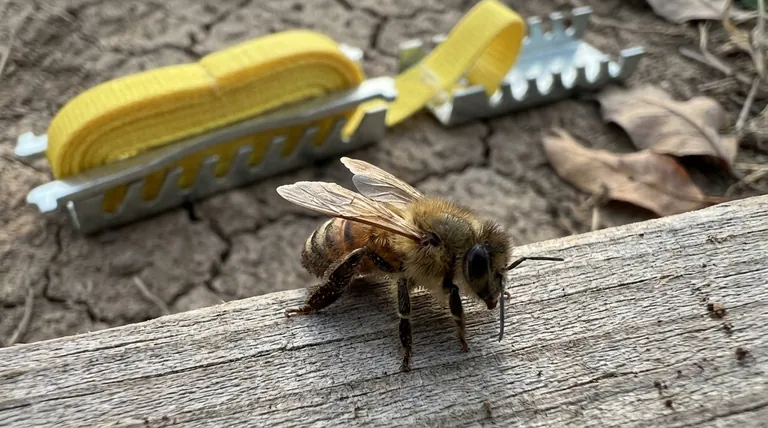When faced with a scarcity of pollen, honey bees are known to engage in desperate foraging behaviors, collecting non-nutritious materials that physically resemble pollen. They have been observed gathering fine particles like sawdust and coffee grounds in an attempt to fulfill their instinctive drive to find the protein necessary for the colony's survival.
While honey bees show remarkable adaptability by searching for pollen substitutes, this behavior is a sign of severe nutritional stress. These alternative materials lack the essential proteins required to raise new bees, meaning this "adaptation" is ultimately a failed strategy that jeopardizes the colony's future.

The Central Role of Pollen
To understand the bees' desperate search, we must first recognize why pollen is non-negotiable for a healthy hive.
Pollen as the Colony's Protein
Pollen is the honey bee's sole source of protein, lipids, vitamins, and minerals. It is the solid food that fuels growth and development.
Fueling the Next Generation
Worker bees process pollen into "bee bread" to feed to larvae (young bees). Without an adequate supply of pollen, the queen may slow or stop laying eggs, and the colony cannot raise brood.
Nectar vs. Pollen
Nectar and honey are carbohydrate-rich and provide energy for adult bees' flight and daily activities. Pollen, however, is for building bodies. A colony can starve from a lack of protein even when it has ample honey stores.
Foraging Adaptations Under Stress
When pollen is unavailable, the innate drive to forage for it remains. This can lead bees to make critical mistakes.
Seeking Pollen-Like Substitutes
Bees have been documented collecting a variety of fine powders, including sawdust, coffee grounds, and dust from livestock feed. The collection appears to be driven by the physical texture and color of the material, not its nutritional content.
The Honey Bee's Travel Advantage
Honey bee colonies have a distinct advantage over most native bee species: a large workforce capable of flying great distances. This allows them to search a much wider radius for resources, including both legitimate pollen sources and these desperate substitutes.
Understanding the Trade-offs
This adaptive behavior comes with a fatal flaw. While it demonstrates the bees' persistence, it does not solve the underlying nutritional problem.
The Illusion of a Solution
Materials like sawdust are primarily cellulose, which bees cannot digest. They offer zero nutritional value. Collecting these substitutes expends a bee's precious energy for no biological gain.
The Inevitable Colony Decline
A colony bringing in sawdust instead of pollen cannot feed its young. Brood production will cease, and the colony's population will dwindle as older bees die off without being replaced. This is a direct path to colony collapse.
A Bioindicator of Environmental Health
Observing bees collecting non-pollen materials is a powerful bioindicator. It signals a severe lack of floral diversity and resources in the local environment, a condition often referred to as a "pollen desert."
How to Interpret This Behavior
Understanding this adaptation allows us to draw clear, actionable conclusions about the state of the hive and its environment.
- If you are a beekeeper: Observing this is a critical signal to immediately provide a supplementary protein source, such as a pollen patty, to prevent colony decline.
- If you are a gardener or land manager: This highlights the urgent need to plant a diverse range of flowers that bloom throughout the seasons, ensuring pollinators have a consistent food supply.
- If you are an ecologist: This behavior serves as a clear, observable data point indicating a significant gap in floral resources and environmental stress on local pollinator populations.
Ultimately, these desperate foraging strategies offer a stark reminder that the health of a honey bee colony is a direct reflection of the health of its surrounding ecosystem.
Summary Table:
| Behavior | Purpose | Outcome |
|---|---|---|
| Collecting Pollen | Provides protein for brood development | Healthy, growing colony |
| Collecting Substitutes (e.g., sawdust) | Instinctive drive to find protein-like materials | Colony decline, as substitutes lack nutrition |
Is your apiary prepared for pollen scarcity? HONESTBEE supplies commercial apiaries and beekeeping equipment distributors with the essential tools and supplements—like high-quality pollen patties—to support colony health and prevent nutritional stress. Ensure your bees have the resources they need to thrive. Contact HONESTBEE today for wholesale solutions.
Visual Guide

Related Products
- Professional Galvanized Hive Strap with Secure Locking Buckle for Beekeeping
- Full Set Beekeeping Electronic Bee Venom Collector Machine Device for Bee Venom Collecting
- Beehive Handle and Frame Rest Cutting Machine: Your Specialized Hive Machine
- Plastic Bee Hive Stand for Beekeeping
- Portable Uncapping Tank Holder Uncapping Bench for Beekeeping
People Also Ask
- Why are hive straps important for beekeepers? Secure Your Hives Against Wind, Predators & Transport
- How should a cam buckle strap be installed for optimal performance? Master the Leverage for Maximum Tension
- What are hive straps and why are they used? Secure Your Hives Against Wind, Predators, and Transport
- What is the best length for straps used around beehives? Why 12 Feet is the Industry Standard
- How can beekeepers secure the top cover of a hive? Protect Your Colony from Wind and Weather



















